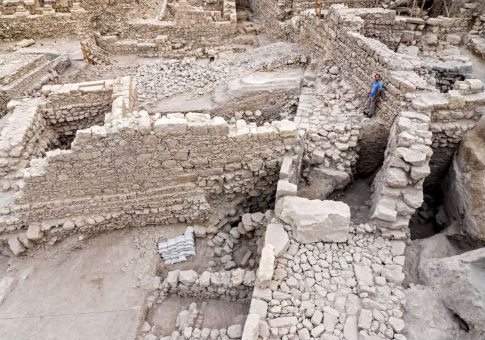Archaeologists announced Tuesday that they have discovered in Jerusalem remains of the Acra, a Greek fortress that plays a central role in the story of Hanukkah.
The researchers discovered the Acra in an excavation of the ancient City of David in the Jerusalem Walls National Park. They uncovered what they believe to be a defensive wall built there during the reign of Antiochus IV Epiphanes, a Greek king who outlawed the Jewish religion and forced Jews to worship pagan gods and goddesses.
The Acra was built by Antiochus to control activity in Jerusalem, especially at the temple. The eight-day celebration of Hanukkah honors the rededication of the second temple in Jerusalem when Jews rose up against Greek rule in the Maccabean Revolt.
Excavators said they found evidence of the Acra, including part of a large wall, a base of a tower four meters wide and 20 meters long, and a defensive embankment called a "glacis" constructed out of soil, stone, and plaster.
Researchers also discovered lead sling shots, bronze arrowheads, and ballistae stones that suggest efforts to conquer the fortress during Antiochus’ rule.
Archaeologists overseeing the Israel Antiquities Authority excavation project called the discovery "sensational," explaining that it has allowed them to understand the layout of the city at the time of the Maccabean Revolt.
"This sensational discovery allows us for the first time to reconstruct the layout of the settlement in the city, on the eve of the Maccabean uprising in 167 B.C.E.," said members of the team in a statement on Tuesday. "The new archaeological finds indicate the establishment of a well-fortified stronghold that was constructed on the high bedrock cliff overlooking the steep slopes of the City of David hill. This stronghold controlled all means of approach to the Temple atop the Temple Mount, and cut the Temple off from the southern parts of the city."
The researchers also stated that coins found at the excavation site "provide evidence of the citadel’s chronology, as well as the non-Jewish identity of its inhabitants."
Various theories about the location of the Acra have been advanced in the last century as artifacts of Greek rule in Jerusalem have remained scarce. The latest findings, the Israel Antiquities Authority said, provide concrete evidence that appears to solve the mystery surrounding the fortress’ location, placing it in the City of David.
Phrases from 1 and 2 Maccabees and writings of the historian Flavius Josephus appear to back up the findings.
"Then builded they the city of David with a great and strong wall, and with mighty towers, and made it a strong hold for them. And they put therein a sinful nation, wicked men, and fortified themselves therein," reads 1 Maccabees 1:33-34.
"When he had overthrown the city walls, he built a citadel in the lower part of the city, for the place was high, and overlooked the temple; on which account he fortified it with high walls and towers, and put into it a garrison of Macedonians," Josephus wrote in the Antiquities of the Jews.
The Givati parking lot excavation in which the Acra was discovered has been underway without interruption since 2007, funded by the Elad Foundation, which operates the Jerusalem Walls National Park. It has uncovered artifacts from different cultures spanning several periods of Jerusalem’s history.
This discovery comes after an October report in the New York Times that appeared to cast doubt on the existence of the two ancient Jewish temples at the Temple Mount, giving fuel to Palestinian accusations that they never existed, and which angered historians and archaeologists.
The Times was force to add an editor’s note to the story clarifying that it "should have made clear that the archaeological and historical uncertainties about the site—unlike assertions by some Palestinians that the temples never existed—do not directly challenge Jewish claims to the Temple Mount."
